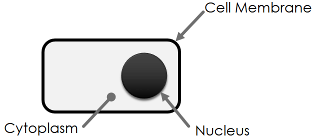Beginning of the End of Cancer

In the last post, I wrote about the beginning of the end of type-2 diabetes. Here is something even more sensational:
Science is beginning to understand cancer and…it is turning out to be a pussy!
Let me explain.
TLDR: calorie restricted ketogenic diet is a powerful anti-cancer tool
All posts in this series
Related series
- Beginning of the End of Type-2 Diabetes
- Beginning of the End of Autoimmune Diseases (to be published)
- Microbiome: Antibiotic for the 21st Century Diseases
Cancer is not a genetic disease
First, some cell physiology. Let me use a hen’s egg as analogy to explain structure of the cells in your body:
- Each cell has a membrane holding its contents (like an egg’s shell).
- Everything inside the cell membrane is called the cytoplasm (like the white of the egg).
- The liquid component of cytoplasm is cytosol.
- Many pieces of cellular machinery float around in the cytosol.
- The largest of the flotilla is called the nucleus of the cell (like the yellow of the egg).
- The nucleus of the cell contains our genetic material (DNA, etc.).
Here is a simplified block diagram of a cell.

You were told that cancer starts when our genes undergo damages (mutations), right? Well, that turns out to be wrong.
Take two cells, one normal and another cancerous, and interchange their nucliei:

If cancer were a result of gene mutations, the cell that ends up with damaged nucleus should become cancerous, right? Surprise, surprise, the opposite happens!

When you put the nucleus of a cancerous cell into a normal cytoplasm, the cell behaves normally. Whereas, when you put an undamaged nucleus into the cytoplasm of a cancer cell, it becomes cancerous. So…
something cytoplasm causes cancer; not the damages to the DNA!
For decades, the cancer treatment strategies were designed to go after the gene mutations. Looks like the culprit is sitting in the cytoplasm all along. No wonder cancer remained untreatable!
Cancer is a metabolic disease
Remember we mentioned earlier that many cellular machinery float in the cytosol? Among them are tiny structures (or organelles (ogranum = tool, organelle = tiny tool (no, not that))) called mitochondria (singular: mitochondrium).

Mitochondria are the power plants of the cells. Each cell has thousands of mitochondria. In a process called aerobic (using air, or oxygen) energy production, mitochondria generate energy for the cells to use.
Billions of years ago, mitochondria were free roaming “animals” like bacteria. Then, the eukaryotic cells (which, we are made up of) captured the mitochondria and made bonded labors out of them. Eukaryotic cells feed and house mitochondria. In return, mitochondria produce fast and ample energy for the eukaryote using oxygen.
Before enslaving the mitochondria, eukaryotic cells used to produce energy through the slower process of fermenting glucose. This energy pathway doesn’t use oxygen. It is called an anaerobic (i.e. without air) pathway or glycolytic pathway.
When the mitochondria in a cell become damaged, they cannot produce energy using the aerobic pathway anymore. So, the cell start to fully depend on the ancient and slower fermentation route. Unfortunately, many of the gene mutations that are responsible for up regulating the fermentation pathways also play a part in:
- Mutation of cell DNA
- Evading programmed cell death (all our cells are programmed to commit suicide under certain circumstances), so damaged/mutated cells continues to live
- Encourage growth of new blood vessels (without sprouting new blood vessels, cancer cells cannot grow into a tumor larger than 0.2mm to 2mm)
So, DNA mutates, evade self-destruct program, encourages new blood vessels to bring it extra energy, resulting in a runaway cell multiplication. The cluster of such cells become a cancerous tumor.
Sensible Cancer Treatment Strategy
When our genes start mutating without oversight (since mitochondrial damage destroys many control systems in the cell), the mutations happen in thousands of ways. Attacking the genetic mutation in a cancer cell is like fighting the Hydra of Lerna. New mutations keep popping up faster than you can kill the old ones.
Fortunately, once you understand that cancer is a metabolic disease, a simpler and more elegant solution becomes available. We know that cancers seem to start with poor aerobic energy production, and that cancer cells rely on glucose as the primary source of energy! So…
if you keep the blood glucose levels in the range of 50-65mg/dL, cancer cells start dying out of hunger.
When the blood glucose goes this low, normal cells with functioning mitochondria can live on by producing energy through alternative means.
To keep the blood sugar levels continuously low, one must eat a lot of healthy fats (about 80% by calorie intake) and very little of proteins (15%) and carbs (5%). This type of diet is called a ketogenic diet.
Wait, there is more
Including the mitochondrial dysfunction, there are a total of 14 vulnerabilities in cancer’s armor:
- Help improve the gene reproductive integrity
- Fix the expression of the damaged DNA
- Inhibit abnormal signal transduction
- Inhibit abnormal transcription activity
- Normalize cell membrane potential
- Normalize mitochondrial function
- Encourage normal cell to cell communication
- Inhibit abnormal blood supply to cancer cells
- Inhibit spreading of cancer cells to distant parts of the body
- Support the immune system
- Maintain cellular detox mechanism
- Normalize cell suicide mechanisms
- Maintain gut function
- Normalize the cancer cells
We have seen how to exploit one of these 14 vulnerabilities, namely mitochondrial dysfunction. Mitochondrial dysfunction is perhaps the worst vulnerability the cancer cells suffer. But to beat cancer, you will have to attack every one of the 14 vulnerabilities.
Funny and incredible as it may sound, despite the billions we have been spending on drug discovery, we have no drugs to fight against any one of these 14 vulnerabilities. Nothing. Nada.
Fortunately there are robust, evidence based (yes, evidence based) diet and nutrition regimen that you can implement to support us with each of these 14 battles. If you go to war with cancer on all these 14 fronts, then…
cancer becomes just another chronic disease to be managed over long term. Like, say, diabetes!
Also, because these interventions are made up of diet and nutrition, they are non-toxic. Nutritional interventions even revitalize a cancer patient and make them stronger.
With nutritional management…
even the patients with the most aggressive form of cancer can live 2 to 5 more years than predicted.
If you buy few more years with nutritional therapy, new medical breakthrough may come along, adding more years. Also…
if you attack an easy-cancer using diet and nutrition, many patients may end up outliving their cancer!
How can I help?
Implementing a comprehensive anti-cancer protocol is super-cumbersome. If someone you know needs help with managing their disease, please get in touch with me either by leaving a comment (or sending me a message form the contact page, if you are concerned about privacy).
I will connect you with my friends who specialize in this area of medicine.
All posts in this series
Related series
- Beginning of the End of Type-2 Diabetes
- Beginning of the End of Autoimmune Diseases (to be published)
- Microbiome: Antibiotic for the 21st Century Diseases
4 thoughts on “Beginning of the End of Cancer”